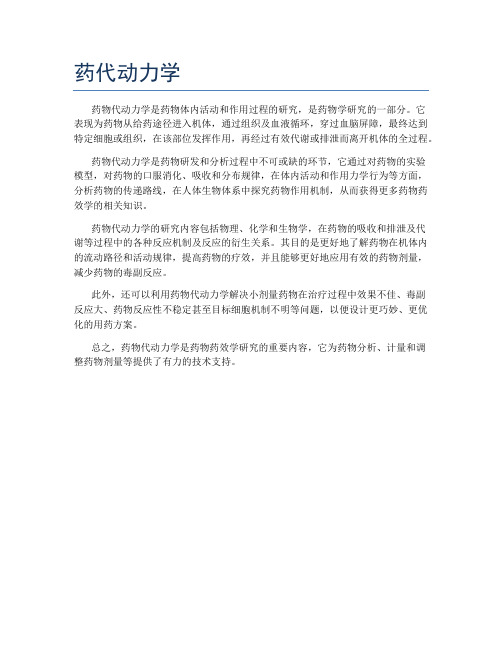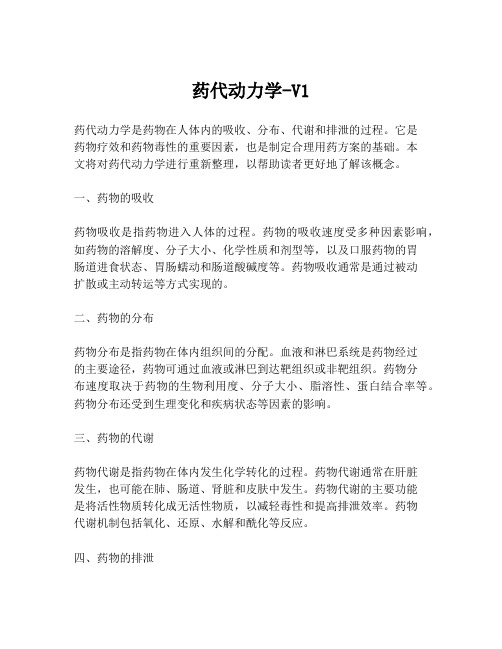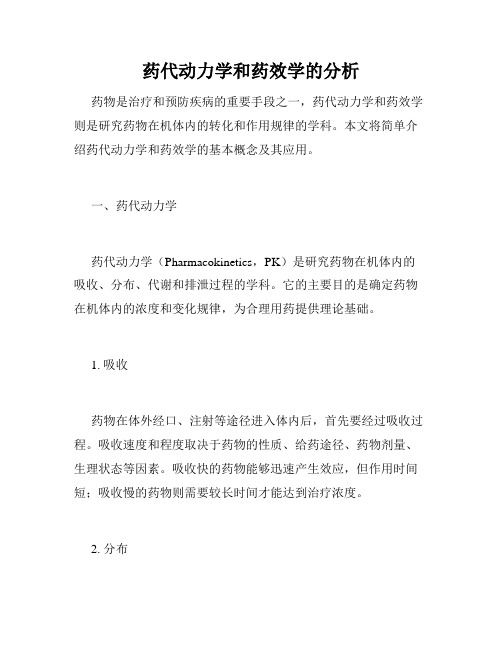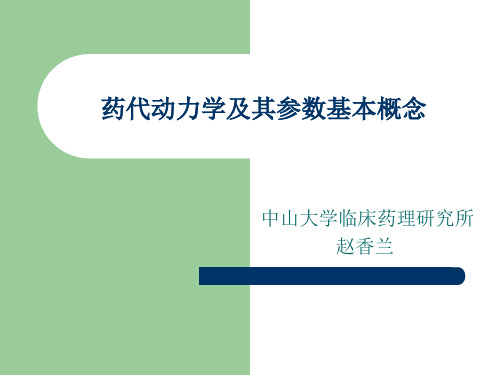药代动力学
药代动力学

药代动力学
药物代动力学是药物体内活动和作用过程的研究,是药物学研究的一部分。
它
表现为药物从给药途径进入机体,通过组织及血液循环,穿过血脑屏障,最终达到特定细胞或组织,在该部位发挥作用,再经过有效代谢或排泄而离开机体的全过程。
药物代动力学是药物研发和分析过程中不可或缺的环节,它通过对药物的实验
模型,对药物的口服消化、吸收和分布规律,在体内活动和作用力学行为等方面,分析药物的传递路线,在人体生物体系中探究药物作用机制,从而获得更多药物药效学的相关知识。
药物代动力学的研究内容包括物理、化学和生物学,在药物的吸收和排泄及代
谢等过程中的各种反应机制及反应的衍生关系。
其目的是更好地了解药物在机体内的流动路径和活动规律,提高药物的疗效,并且能够更好地应用有效的药物剂量,减少药物的毒副反应。
此外,还可以利用药物代动力学解决小剂量药物在治疗过程中效果不佳、毒副
反应大、药物反应性不稳定甚至目标细胞机制不明等问题,以便设计更巧妙、更优化的用药方案。
总之,药物代动力学是药物药效学研究的重要内容,它为药物分析、计量和调
整药物剂量等提供了有力的技术支持。
药代动力学-V1

药代动力学-V1药代动力学是药物在人体内的吸收、分布、代谢和排泄的过程。
它是药物疗效和药物毒性的重要因素,也是制定合理用药方案的基础。
本文将对药代动力学进行重新整理,以帮助读者更好地了解该概念。
一、药物的吸收药物吸收是指药物进入人体的过程。
药物的吸收速度受多种因素影响,如药物的溶解度、分子大小、化学性质和剂型等,以及口服药物的胃肠道进食状态、胃肠蠕动和肠道酸碱度等。
药物吸收通常是通过被动扩散或主动转运等方式实现的。
二、药物的分布药物分布是指药物在体内组织间的分配。
血液和淋巴系统是药物经过的主要途径,药物可通过血液或淋巴到达靶组织或非靶组织。
药物分布速度取决于药物的生物利用度、分子大小、脂溶性、蛋白结合率等。
药物分布还受到生理变化和疾病状态等因素的影响。
三、药物的代谢药物代谢是指药物在体内发生化学转化的过程。
药物代谢通常在肝脏发生,也可能在肺、肠道、肾脏和皮肤中发生。
药物代谢的主要功能是将活性物质转化成无活性物质,以减轻毒性和提高排泄效率。
药物代谢机制包括氧化、还原、水解和酰化等反应。
四、药物的排泄药物排泄是指药物从体内排出的过程。
药物排泄主要通过尿液、粪便、汗液和呼吸等途径进行。
药物的排泄速度取决于肾脏、肝脏和肺脏等器官功能的健康情况,也受到血流量、药物的离子化程度和药物结合蛋白的影响。
总之,药代动力学是药物在体内吸收、分布、代谢和排泄的过程,是合理用药的基础。
我们需要了解药代动力学的各个方面,以便更好地理解药物的作用和副作用。
药物的药代动力学与药效动力学

药物的药代动力学与药效动力学药物的药代动力学与药效动力学是药物研发和应用的重要概念和原理。
药代动力学研究药物在体内的吸收、分布、代谢和排泄过程,而药效动力学研究药物对生物体产生的药理效应。
一、药代动力学1. 药物吸收药物吸收是指药物从给药部位进入血液循环的过程。
吸收速度和程度直接影响药物的药效。
吸收途径包括口服、注射、吸入等。
药物在吸收过程中受到许多因素的影响,如溶解度、pH值、渗透性等。
2. 药物分布药物分布是指药物在体内分布到各组织器官的过程。
药物与血浆蛋白结合率、脂溶性、离子化程度等因素都会影响药物的分布。
此外,血液供应充足的组织器官吸收药物更多,而脂溶性较高的药物则更容易穿过细胞膜。
3. 药物代谢药物代谢是指药物在体内被酶系统代谢为代谢产物的过程。
主要发生在肝脏中的肝酶系统。
药物代谢会影响药物的活性和持续时间,也是药物相互作用的重要因素。
代谢产物可能具有药理活性,也可能是毒性产物。
4. 药物排泄药物排泄是指将代谢产物从体内排出的过程。
主要通过肾脏排泄尿液,也可以通过粪便、呼吸、汗液等途径。
药物的排泄速度与药物的解离速度、肾小管分泌速率等因素有关。
二、药效动力学药效动力学是研究药物对生物体产生的药理效应的学科。
它可以描述药物的剂量-效应关系、治疗窗口、作用机制等。
药物的药效动力学特性是影响临床应用的重要因素。
1. 剂量-效应关系剂量-效应关系研究药物剂量与产生的效应之间的关系。
通常可以分为线性和非线性关系。
线性关系表示药物剂量增加或减少,效应也相应等比例增加或减少。
非线性关系则表示剂量增加或减少,效应并不等比例变化。
2. 治疗窗口治疗窗口是指药物在体内能够产生治疗效果的浓度范围。
在治疗窗口内,药物能够发挥治疗作用;而超出治疗窗口,剂量过高或过低都可能导致药物的不良反应或治疗失败。
3. 作用机制药效动力学也研究药物的作用机制,即药物与靶点结合后产生的药理效应的分子机制。
药物的作用机制研究对于合理用药、药物研发和药物治疗具有重要意义。
药代动力学和药效学的分析

药代动力学和药效学的分析药物是治疗和预防疾病的重要手段之一,药代动力学和药效学则是研究药物在机体内的转化和作用规律的学科。
本文将简单介绍药代动力学和药效学的基本概念及其应用。
一、药代动力学药代动力学(Pharmacokinetics,PK)是研究药物在机体内的吸收、分布、代谢和排泄过程的学科。
它的主要目的是确定药物在机体内的浓度和变化规律,为合理用药提供理论基础。
1. 吸收药物在体外经口、注射等途径进入体内后,首先要经过吸收过程。
吸收速度和程度取决于药物的性质、给药途径、药物剂量、生理状态等因素。
吸收快的药物能够迅速产生效应,但作用时间短;吸收慢的药物则需要较长时间才能达到治疗浓度。
2. 分布分布是指药物进入血液后在体内的扩散过程。
药物与组织的亲和力和组织的血供量是决定分布的重要因素。
有些药物可以结合蛋白质而不能穿过血脑屏障,不能直接作用于中枢神经系统;有些药物则能穿过血脑屏障,直接作用于中枢神经系统,这些药物有睡眠药、抗抑郁药等。
3. 代谢药物在体内会发生代谢作用,被代谢的药物称为代谢产物或代谢物。
代谢主要发生在肝脏,也可在肺、肾等器官中进行。
药物代谢的过程可分为两个阶段:相位Ⅰ和相位Ⅱ。
相位Ⅰ通常是由细胞色素P450酶系统参与肝脏细胞的氧化反应,通过加羟基、氨基、羧基等来使药物变得更加水溶性,降低其毒性,增强其排泄。
相位Ⅱ代谢通常需要与协同参与,主要是利用各种转移酶催化药物中的羟基、胺、硫等官能团,结合肝细胞中的各种底物(如乙酰辅酶A),使之转化为极性的代谢物。
4. 排泄药物代谢的最终结果是生成溶于水的代谢物,它们经由肾脏、肝脏、肺、肠道和汗腺等排泄器官从体内排泄。
代谢产物还包括未被代谢的药物,这些药物在体内的浓度过高可能会产生毒性。
药物在人体内的廓清速率决定其在体内维持一定的浓度水平的时间,越慢则作用时间越长。
药代动力学包括多个方面,其具体应用范围和目的包括但不限于:1. 确定药物的最佳剂量:在理解药物吸收、分布、代谢和排泄的过程后,医师可以知道患者需要多少剂量才能达到治疗效果。
药代动力学及其参数基本概念

正常受试者药代动力学研究
——单剂量给药的临床药代动力学研究
二、试验设计
一般应选用高、中、低3个剂量组,根据人体 耐受性试验的结果 高剂量组的剂量一般应高于临床试验的治疗 剂量,但不应超过人体的最大耐受剂量 受试人数:每组8~12例
正常受试者药代动力学研究
——单剂量给药的临床药代动力学研究
三、 试验操作步骤
三种单剂量的药代动力学试验结果反映不同药物 剂量(小、中、大剂量)的吸收和消除动力学的 规律是线性或非线性动力学
正常受试者药代动力学研究
——单剂量给药的临床药代动力学研究
五、药代动力学参数的估算
线性或非线性动力学的判断标准举例:依立雄胺 (epristeride)的9名健康男性受试者单剂量口服 5 mg、10 mg、20 mg爱普列特片剂进行药代动 力学研究结果如下(表8-2、表8-3)
或因与血浆蛋白结合力高,不易进入组织,其Vd 值常较小,约为0.15~0.3L/kg;与此相反,碱性 有机药物如苯丙胺、山莨菪碱等易被组织所摄取, 血中浓度较低,Vd值常超过体液总量(60kg的正 常人,体液约36L,即0.6L/kg)。例如,地高辛 的Vd达600L(10 L/kg),说明该药在深部组织大 量储存。
物效的 浓最 度临低 。床中最毒佳浓效度果,是(维C持SS)药min物大的于(药CS物S)m的ax最小低于有药
(六)负荷剂量(Loading dose,DL)
概念:临床上为了使药物尽快到达稳态 从而尽早发挥疗效,常常先给予一个较维持 剂量大的剂量使药物迅速达到稳态水平,然 后在预定的给药间隔时间给予维持剂量维持 稳态水平,这个在第一次使用的剂量称为负 荷剂量。
应用
3. 根据表观分布容积调整剂量 通常药物的表观分布容积与体表面积成正
药代动力学参数及其意义

药代动力学参数及其意义
药代动力学参数是指描述药物在体内的吸收、分布、代谢和排泄过程的定量指标,常见的药代动力学参数包括:
1. 绝对生物利用度(absolute bioavailability):衡量药物在口服后被吸收到循环系统的百分比,是评价给药途径有效性的重要指标。
2. 血浆最高浓度(peak plasma concentration,Cmax):药物在给药后达到的最高浓度,反映了药物在体内的吸收速度。
3. 血浆最低浓度(trough plasma concentration,Cmin):药物在给药间隔期内达到的最低浓度,用于评价维持药物疗效的药物剂量。
4. 血浆半衰期(plasma half-life,t1/2):药物在体内降解或排除的速度所需的时间,衡量药物代谢和排泄的速度。
5. 消除常数(elimination constant,K):衡量药物在体内消除的速率,通常与血浆半衰期相关。
6. 清除率(clearance):衡量单位时间内从体内完全清除药物的能力,常用于调整药物剂量。
这些参数对于优化药物给药方案、确定药物的剂量和给药频率,以及设计药物动力学模型等方面具有重要意义。
药代动力学参数的测定可以通过体内、体外实验以及药物浓度的测定来获得。
药代动力学参数及其意义
药代动力学参数及其意义1. 引言药代动力学(Pharmacokinetics,简称PK)是研究药物在体内吸收、分布、代谢和排泄过程的科学。
药代动力学参数是描述药物在体内动力学过程的定量指标,对于药物的疗效和安全性评价具有重要意义。
2. 药代动力学参数的分类药代动力学参数主要分为吸收动力学参数、分布动力学参数、代谢动力学参数和排泄动力学参数。
2.1 吸收动力学参数吸收动力学参数描述药物从给药部位到达循环系统的过程。
常用的吸收动力学参数有峰浓度(Cmax)、时间峰浓度(Tmax)、面积下曲线(AUC)等。
•Cmax是药物在体内达到的最高血药浓度,反映了药物在给药后的吸收速度和程度。
•Tmax是药物达到最高血药浓度的时间点,可以用来评估药物的快慢吸收。
•AUC是药物在一定时间内血药浓度与时间曲线下的面积,反映了药物在体内的总体吸收程度。
2.2 分布动力学参数分布动力学参数描述药物在体内分布到各组织和器官的过程。
常用的分布动力学参数有分布容积(Vd)和蛋白结合率。
•Vd是药物在体内分布的虚拟容积,反映了药物在体内的分布广度。
•蛋白结合率是药物与血浆蛋白结合的比例,影响药物的分布和药效。
2.3 代谢动力学参数代谢动力学参数描述药物在体内经肝脏等器官代谢的过程。
常用的代谢动力学参数有清除率(CL)和半衰期(t1/2)。
•CL是药物在单位时间内从体内清除的量,反映了药物的代谢速度。
•t1/2是药物在体内消失一半的时间,反映了药物的代谢速度和持续时间。
2.4 排泄动力学参数排泄动力学参数描述药物从体内排除的过程。
常用的排泄动力学参数有排泄率和清除率。
•排泄率是药物从体内排泄的速率,反映了药物的排泄速度。
•清除率是药物从体内清除的速率,反映了药物的总体排泄能力。
3. 药代动力学参数的意义药代动力学参数对于药物的疗效和安全性评价具有重要意义。
3.1 疗效评价药代动力学参数可以反映药物的吸收速度、峰浓度和总体吸收程度,对药物的疗效产生影响。
药代动力学数据
对药代动力学数据随时间变化的情况进行分析,如预测未来值。
数据分析方法
数据变换
对数据进行适当的数学变换,如对数转换、标准化等,以改善数据的分布特性和可比性。
数据清洗
对原始数据进行预处理,如缺失值填充、异常值处理等,以确保数据质量。
数据分组
根据研究目的和实验设计,将数据分成不同的组别或类别。
确保实验操作符合相关规范和标准,减少误差和偏差。
定期对分析仪器进行校准和维护,确保仪器性能稳定可靠。
数据质量控制
03
CHAPTER
药代动力学数据分析
对数据进行描述性统计,如求平均值、中位数、标准差等,以了解数据的分布情况。
描述性统计分析
假设检验
回归分析
时间序列分析
通过设定假设并进行检验,判断数据是否符合预期,如比较两组数据的差异是否具有统计学显著性。
组织分布法
通过测量组织中药物的分布情况来评估药物在体内的分布和靶向性。
微生物法
通过微生物转化或代谢药物来研究药物的理
准确记录每个时间点的药物浓度或代谢产物数据,并进行整理和分析。
测定
采用适当的分析方法对处理后的样品进行药物浓度或代谢产物的测定。
样品处理
对采集的样本进行预处理,如分离血浆、尿液或组织提取物等。
解读数据间的关系
分析药代动力学数据与其他数据之间的关系,如药物浓度与疗效之间的关系。
数据分析结果解读
04
CHAPTER
药代动力学数据应用
药物研发与优化
药代动力学数据可以揭示药物在体内的代谢过程,包括代谢产物的生成和排泄,有助于优化药物的代谢特性。
药物代谢
药药代动力学研究方法
药药代动力学研究方法目录一、内容概览 (2)1. 研究背景与意义 (3)1.1 药物研发的重要性 (4)1.2 药物代谢动力学研究的目的与意义 (5)2. 研究方法与论文结构 (6)2.1 研究方法介绍 (7)2.2 论文组织结构 (9)二、药代动力学基础概念与理论 (10)1. 药代动力学定义及研究内容 (11)1.1 药代动力学的概念 (13)1.2 药代动力学研究的主要内容 (13)2. 药物在体内的过程 (15)2.1 药物的吸收 (16)2.2 药物的分布 (18)2.3 药物的代谢 (20)2.4 药物的排泄 (21)三、药代动力学研究方法与技术 (22)1. 实验设计 (23)1.1 实验动物的选择与分组 (24)1.2 给药方案的设计 (26)1.3 采样点的设置与样本处理 (26)2. 药学实验技术与方法应用 (28)一、内容概览药药代动力学(Pharmacokinetics,简称PK)研究方法主要关注药物在体内的动态变化过程,包括药物的吸收、分布、代谢和排泄等过程。
这些研究方法的应用对于理解药物的安全性、有效性和合理性具有重要意义。
在本研究中,我们采用多种先进的药药代动力学研究方法,以确保结果的准确性和可靠性。
具体包括:血药浓度法:通过测定不同时间点血液中的药物浓度,计算出药物的消除速率常数、生物利用度等参数。
这种方法适用于大多数口服和静脉注射给药的药物。
生理药物代动力学模型:基于解剖学和生理结构建立的药物体内动态模型,能够模拟药物在体内的分布、代谢和排泄过程,提供更为精确的药代动力学参数。
统计矩方法:通过对血药浓度时间曲线进行拟合,计算出药物的吸收速率常数、达峰时间、半衰期等参数。
这种方法适用于非线性药动学特征明显的药物。
生物效应法:通过观察药物对生物体的药理效应,间接反映药物在体内的动态变化过程。
这种方法适用于那些药理作用与血药浓度无直接关系的药物。
模型模拟与实验验证:将建立的数学模型与实验数据进行对比和分析,不断优化模型的结构和参数,以提高研究的准确性和可靠性。
药理学 第2章 药物代谢动力学
等量等间隔多次给药血中积累药物总药量
t1/2数
给药后的
经过半衰期药量
1
100% A0
50% A0
2
150% A0
75% A0
3
175% A0
87.5% A0
4
187.5% A0
93.8% A0
5
193.8% A0
96.9% A0
6
196.9% A0
98.4% A0
7
198.4% A0
99.2% A0
常用药动学参数
1.. 血浆半衰期:
Half-life (in Conc.-Time Curve)
是临床用药间隔的依据
Half-Life The amount of time required to rid the body of half of the initial concentration of the drug.
三、药物的分布:
影响药物分布的因素: 1.药物与血浆蛋白结合; 2.局部器官的血流量; 3.体液pH; 4.组织亲和力; 5.体内屏障,包括血脑屏障和胎盘屏障。
血浆蛋白结合(Plasma protein binding)
D+P
DPc
可逆性(Reversible equilibrium) 可饱和性(Saturable)
血脑屏障
(Blood-brain barrier, BBB)
由毛细血管 壁和N胶质细 胞构成
Blood Brain Barrier
四、生物转化 (transformation / metabolism)
又称为药物代谢,是药物在体内发生的 化学变化,药物经转化后成为极性高的 水溶性代谢物而利于排出体外。
- 1、下载文档前请自行甄别文档内容的完整性,平台不提供额外的编辑、内容补充、找答案等附加服务。
- 2、"仅部分预览"的文档,不可在线预览部分如存在完整性等问题,可反馈申请退款(可完整预览的文档不适用该条件!)。
- 3、如文档侵犯您的权益,请联系客服反馈,我们会尽快为您处理(人工客服工作时间:9:00-18:30)。
ORIGINAL RESEARCH ARTICLEMultiple Dose Pharmacokinetics and Safety of Sulcardine Sulfate in Healthy Chinese Male Subjects:An Open-Label Phase I Clinical StudyWei Wang 1•Hong-jie Qian 2•Liang Xin 2•Meng-qi Zhang 2•Dong-ying Lu 4•Jie-mei Jin 2•Gang-yi Liu 2•Jing-ying Jia 2•Hong-chao Zheng 3•Chen Yu 2•Yi-ping Wang 4•Fu Zhu 3•Yun Liu 2ÓSpringer International Publishing Switzerland 2016AbstractBackground Sulcardine sulfate is a novel antiarrhythmic agent with mechanism of action as a multi-ion channel blocker.Preclinical studies in animal models have demonstrated that sulcardine sulfate is efficacious in atrial and ventricular arrhythmias,and consequently,leads to the prevention of sudden cardiac death.Objectives This study was conducted in healthy Chinese male subjects to investigate the pharmacokinetic profile and safety of sulcardine sulfate after repeated oral dose administration at 200,400,and 800mg for 5days.Methods Thirty-three male subjects were enrolled in this study.In the multiple dose phase,sulcardine sulfate was administered orally twice at the interval of q12h since day 3.Sulcardine sulfate plasma concentration was determined using a validated LC–MS/MS method.Safety was assessed using clinical evaluation and AE monitoring.Results In this repeated dose study,pharmacokinetic parameters (C max ,AUC (0–t ),and C ss_av)increased with the increase in dose (the dose ratio of the three cohorts was 1:2:4,while the ratio of C max and AUC (0–t )at day 1was around 1:4:9and 1:4:6,respectively),but in a non-linear fashion.The accumulation ratio at steady state (AR)of 200,400,and 800mg dose level was 1.18,1.69,and 2.13,respectively,indicating that sulcardine sulfate has a modest accumulation upon repeated dose administration.Moni-toring of pre-dose plasma concentrations on days 6,7,and 8for each dose level indicated that steady state was achieved at day 6after three-day repeated dosing.Conclusions Pharmacokinetic characteristics of sulcardine sulfate were shown to be non-linear,with the modest accumulation upon repeated dosing,and sulcardine sulfate was safe and well tolerated.The pharmacokinetic characteristics of sulcardine sulfate were non-linear.Sulcardine sulfate was shown to have modest accumulation upon repeated dosing.Sulcardine sulfate was well tolerated in healthy Chinese male subjects.&Fu Zhuzhufu@ &Yun Liuyliu@1Emergency Ward,Shanghai Xuhui Central Hospital and Zhongshan-Xuhui Hospital,Fudan University and Shanghai Clinical Center,Chinese Academy of Science,Shanghai,China2Department of Cardiology,Shanghai Xuhui Central Hospital and Zhongshan-Xuhui Hospital,Fudan University and Shanghai Clinical Center,Chinese Academy of Science,Shanghai,China3Department of Cardiology,Shanghai Xuhui Central Hospital and Zhongshan-Xuhui Hospital,Fudan University and Shanghai Clinical Center,Chinese Academy of Science,Shanghai,China4Department of Pharmacology,State Key Laboratory of Drug Research,Shanghai Institute of Materia Medica,Chinese Academy of Sciences,Shanghai,ChinaEur J Drug Metab Pharmacokinet DOI 10.1007/s13318-016-0370-11IntroductionArrhythmia is a common clinical abnormality,induced by not only several cardiovascular diseases,such as coronary heart disease,hypertension,and myocarditis[1],but also certain medications[2,3].Antiarrhythmic medications have been used to treat arrhythmia since several decades ago,and new treatments are being developed continuously [4].Sulcardine sulfate is a novel antiarrhythmic agent that is currently in clinical trials as a potential treatment for atrial fibrillation and ventricular arrhythmias.Sulcardine sulfate exerts blocking effects on sodium,potassium,and calcium ion channels.Sulcardine sulfate does not induce early after-depolarizations or other electrophysiological abnormalities [5].In animal studies against aconitine-induced arrhyth-mias in rats and ouabain-induced arrhythmias in guinea pigs,sulcardine sulfate was demonstrated to have potent efficacy in anti-atrialfibrillation and anti-ventricular tachycardia as a multi-ion channel blocker[6].Moreover, sulcardine sulfate has been shown to suppress ventricular arrhythmias in the conscious canine model of sudden car-diac death and to prevent the development of ventricular fibrillation in response to an acute ischemic event at a site distant from an area of previous myocardial infarction.The antiarrhythmic actions of sulcardine sulfate make the experimental drug a potential candidate for continued studies in humans to determine its efficacy in treating atrial and ventricular arrhythmias and preventing secondary sudden cardiac death[7,8].In a single-dose Phase I study,ten healthy subjects were enrolled in cohorts A,B,C,and D(sulcardine sulfate doses of200,400,and800mg under fasting condition and400mg post-meal)in a crossover design. Sulcardine sulfate was shown to be safe and well toler-ated in healthy Chinese subjects.Pharmacokinetic profile demonstrated that maximum plasma concentration C max and area under the plasma concentration-time curve (AUC)from time zero to the last quantifiable time AUC(0–t)increased correspondingly with the dose increasing of sulcardine sulfate.There was no significant differences in time to reach C max(T max)and terminal elimination half-life(t1/2)among cohorts A,B,and C (P[0.05).No significant difference was identified between male and female in main pharmacokinetic parameters other than t1/2.Furthermore,no food effect was observed on the absorption and bioavailability of sulcardine sulfate(P[0.05)(Data onfile).The current open-label,multiple dose Phase I study was designed to investigate the pharmacokinetic profile and safety of sulcardine sulfate in healthy Chinese male sub-jects after repeated dose of200,400,and800mg.2Subjects and Methods2.1Study Design and PopulationThis was an open-label,multiple dose study in healthy Chinese subjects,conducted at a single center.The study protocol was approved by an independent ethics commit-tee,and the study was conducted in accordance with the guidelines for Good Clinical Practice recommended by the Chinese Food and Drug Administration[9]and with the ethical standards for human experimentation established in the Declaration of Helsinki[10].All subjects provided written informed consent prior to start of study-related procedures.Subjects who met the following inclusion criteria,while did not meet the exclusion criteria,were eligible to par-ticipate in the study.Inclusion criteria are:(1)male subject between18and45years of age;(2)subject with a body mass index(BMI)between19and24kg/m2(included);(3) no medical history of heart,liver,renal,digestive tract,and hematological system;(4)no allergy history;and(5)in good health as determined by the investigator on the basis of vital signs,physical examination,12-lead ECG,and results of laboratory tests during Screening.Exclusion criteria are:(1)having a history of tumor,orthostatic hypotension,or psychosis;(2)positive hepatitis B virus surface antigen or hepatitis C virus antibody;positive HIV test result;(3)use of any drug(except for acetaminophen) within2weeks prior to screening;(4)participation in any clinical trial within3months;(5)blood donation within 3months;(6)heart rate\45,or[100beat/min;systolic BP[140mmHg,or diastolic BP[90mmHg;and(7) using drugs or alcohol in excess.Based on the results of previous Phase I tolerability study and single-dose pharmacokinetic study of sulcardine sulfate,the dose level of this multiple dose study was selected as200,400,and800mg.This study was designed with three cohorts(Cohort A200mg,Cohort B400mg, and Cohort C800mg).Since no significant difference was observed in C max and AUC between male and female in previous single-dose study of sulcardine sulfate,only male healthy subjects were included for this multiple dose study. According to the SFDA(State Food and Drug Adminis-tration of China)Technical Guidance for Clinical Phar-macokinetics Research on Chemical Drug(2005),the recommended sample size is8–12subjects for each dose level[11].Therefore,11male subjects were enrolled in each of the three cohorts,33subjects in total.Based on the result of t1/2(around17h)in the single-dose study,the administration interval of sulcardine sulfate was deter-mined every12h(twice daily)for the multiple dose study. Theflow chart of dosing sequence is demonstrated inW.Wang et al.Fig.1.Eligible subjects were admitted to the Phase I unit one day before drug administration.Sulcardine sulfate was 200mg per tablet,thus two tablets would be administered for 400mg,while four tablets for 800mg.In the morning of day 1,subjects received sulcardine sulfate at the respective dose levels orally after an overnight fast of 12h,and water deprivation of 2h.Starting from day 3,subjects began to take sulcardine sulfate orally at the respective dose levels at the interval of q12h.The morning dose at day 8was the last dose for multiple dose phase.All doses were administered with 200mL of water.Cigarette,alco-hol,tea,and beverage containing caffeine were prohibited during the entire study.2.2Pharmacokinetic AssessmentsApproximately 2mL of venous blood was collected via an indwelling cannula at each time point.At day 1,blood samples were collected at pre-dose and post-dose at 0.25,0.5,0.75,1,1.25,1.5,2,3,4,6,8,12,24,and 48h,15collection points in total.During the multiple dose phase,blood samples were collected twice a day pre-dose from day 6(but only prior to morning dose for cohort C),to monitor whether steady state has been reached.On day 8,blood samples were collected at pre-dose and post-dose at 0.25,0.5,0.75,1,1.25,1.5,2,3,4,6,8,12,24,and 48h.The collected blood samples were centrifuged at 3000r/min for 10min at 4°C within 30min to obtain plasma.Sulcardine sulfate plasma concentrations were deter-mined using a validated liquid chromatography and tandem mass spectrometery (LC-MS/MS)method.D4-sulcardine sulfate was chosen as the internal standard.The calibration curve was linear over the concentration range from 5.0to 1000ng/mL,resulting in a correlation coefficient r [0.9983.The intra-and inter-batch precisions of sul-cardine sulfate ranged from 2.4to 9.2%and from 3.8to 10.5%.The intra-and inter-batch accuracies of sulcardinesulfate ranged from 93.1to 103.9%and from 84.9to 107.3%[12].Pharmacokinetic parameters were analyzed by non-compartmental models using the DAS 2.0software (DAS 2.0software was purchased from University of Science and Technology,Hefei,China).Plasma pharmacokinetic parameters included area under the concentration–time curve (AUC),maximum observed plasma concentration (C max ),time to maximum plasma concentration (T max ),terminal elimination half-life (t 1/2),and mean residence time (MRT (0–t )).AUC from time zero (pre-dose)to the time of the last measurable concentration (AUC (0–t ))and AUC from time zero (pre-dose)to infinite time (AUC (0–?))were calculated using a combination of linear (before T max )and logarithmic (after T max )trapezoidal methods.For sin-gle-dose administration only,AUC (0–?)was calculated as AUC (0–t )?C t /k z ,where t is the time of last quantifiable concentration,C t is the last quantifiable concentration,and k z is the terminal plasma elimination rate-constant.For multiple dose administration,AUC at steady state (AUC ss ),maximum and minimum plasma concentration at steady state (C ss_max ,C ss_min )were assessed.Average plasma concentration at steady state (C ss_av )was calculated as AUC ss(0–s )/s ,where s is the dosing interval.Degree of fluctuation (DF)was calculated as [(C ss_max -C ss_min )/C ss_av ]9100%to determine the fluctuation of plasma concentration at steady state.Accumulation ratio at steady state (AR)was calculated as (AUC ss(0–s ),day 8)/(AUC (0–?),day 1).2.3Safety and Tolerability AssessmentsTolerability was assessed using physical examination,vital sign measurements (including body temperature,blood pressure,heart rate,and breathing rate),12-lead ECG,echocardiogram,and laboratory measurements (including hematology,serum chemistry,thyroid function test,and urinalysis).Assessment was conducted before first dose,days 3–7after first dose,as well as 48h after last dose (the time point differed for different measurements and cohorts).Adverse events (AEs)were monitored throughout the study.Adverse event was defined as any unfavourable and unintended sign (including an abnormal laboratory finding),symptom,or disease,whether or not related to the use of sulcardine sulfate.All AEs were recorded and evaluated by investigators in terms of severity (mild,moderate,or severe),duration,seriousness,outcome,and relationship to study drug.2.4Statistical AnalysesStatistical analysis was performed using the SAS version 8.0(SAS Institute Inc,Cary,North Carolina).BaselineandFig.1Flow chart of sulcardine sulfate (Sul)dosing sequence.N number of subjects,Bid twice daily,PK pharmacokineticMultiple Dose Pharmacokinetics and Safety of Sulcardine Sulfatedemographic characteristics,safety data,and pharmacoki-netic parameters of sulcardine sulfate were summarized using descriptive statistics.AEs are summarized by fre-quencies and percentages.ANOVA was used to compare the sulcardine sulfate pre-dose plasma concentration among days6,7,and8.A value of P\0.05was consid-ered statistically significant,and P\0.01was remarkably significant.3Results3.1Demographics of the Study PopulationThirty-three healthy Chinese male subjects,11subjects in cohorts A,B,and C,respectively,were enrolled in this study.All33subjects completed the study per protocol. The demographics of enrolled subjects in the three cohorts are demonstrated in Table1.3.2Pharmacokinetic PropertiesThe main pharmacokinetic parameters of sulcardine sulfate administered at200,400,and800mg during single-dose phase(day1)are presented in Table2.The corresponding arithmetic mean(SD)sulcardine sulfate plasma concen-tration–time profiles at day1are displayed in Fig.2.The dose ratio of the three cohorts was1:2:4,while the ratio of C max and AUC(0–t)at day1was around1:4:9and1:4:6, respectively.Especially at the lower dose range (200–400mg),the exposure increased more than propor-tionally(49)as the dose doubles.R2of linear regression analysis[log e transformed C max and AUC(0–t)to log e transformed dose]was0.6123and0.6115,suggesting that the exposure increased in a non-linear fashion with increase in ing confidence interval criteria to assess the dose proportionality displayed that the linearity of sulcardine sulfate could not be decided within 200–800mg.Main pharmacokinetic parameters of sulcardine sulfate administered at200,400,and800mg during multiple dose phase(day8)are presented in Table3.The corresponding arithmetic mean(SD)sulcardine sulfate plasma concentration–time profiles at day8are displayed in Fig.3. The accumulation ratio at steady state(AR)of200,400, and800mg dose level was1.18,1.69,and2.13,respec-tively,indicating that sulcardine sulfate has a modest accumulation upon repeated dosing,and the accumulation is more profound at higher dose level.At steady state,the ratio of average concentration(C ss_av)for the three dose cohorts was1:5:9,again confirming non-linear pharma-cokinetics of sulcardine sulfate within200–800mg(R square of linear regression analysis[log e transformed C ss_av to log e transformed dose]was0.7436).Table4demonstrates the sulcardine sulfate plasma concentration of days6,7,and8pre-dose at200,400,and 800mg.There was no significant ascending trend of C min from day6to day8.No significant difference was found among plasma concentration of different time points for each dose level(P[0.05),which indicated that steady state was achieved at day6after three-day repeated dosing.3.3Safety and TolerabilityFor safety parameters(vital signs,12-lead ECG,ejection fraction in echocardiogram),no clinically significant changes were observed among the33subjects afterfive-day repeated dosing.All AEs observed during the entire study are listed in Table5.The most frequently reported AE was the increase of triglyceride,occurring infive subjects(15.2%).The increase of total bilirubin and dizziness took second place,occurring in three subjects (9.1%),respectively.AEs were recovered before study was over,or were followed up until recovery after study was over.No deaths or serious AEs were reported throughout the study.4DiscussionThis open-label,multiple dose Phase I study was aimed to investigate the pharmacokinetic profile and safety of sul-cardine sulfate in healthy Chinese subjects after repeated dose of200,400,and800mg.Previously,mean t1/2was reported to be17h from a single-dose study at200,400, and800mg dose levels,thus the dosing interval wasTable1Demographics of enrolled subjects in cohorts A, B,and C Demographics Cohort A(n=11)Cohort B(n=11)Cohort C(n=11)Age(years)22.8(2.3)22.4(1.9)25.3(2.9)Height(cm)171(6.7)172(3.0)169(4.9) Weight(kg)61(7.8)61(3.0)59(4.7)BMI(kg/m2)20.8(2.0)20.5(1.1)20.6(1.4)Data are expressed as arithmetic mean(SD)BMI body mass index,SD standard deviationW.Wang et al.determined as every 12h (twice daily)for the current multiple dose study.In the previous single-dose Phase I study at 200,400,and 800mg,the ratios of C max and AUC (0–t )were 1:2.78:7.74and 1:2.39:6.22,suggesting that C max andAUC (0–t )increased in a manner that was slightly more than proportional to the dose increase from 200to 800mg.While in this multiple dose study,pharmacokinetic parameters C max and AUC (0–t )during single-dose phase (day 1),as well as C ss_av after repeated dosing (day 8)increased in a non-linear fashion with increase in dose and the increase was more than proportional at lower dose range,which was consistent with the result of the previous single-dose study.This indicates a non-linear elimination of sulcardine sulfate.It is supposed that saturation may exist in the elimination phase,causing by the saturation of metabolic enzyme or transporters during elimination phase.As for the more than proportional increase at lower dose range,one hypothesis is that there are two metabolic or elimination pathways for sulcardine sulfate,one operates at the entire dose range with limited capacity,and the other operates only at the higher dose range (high Km enzyme).Due to the observed non-liner pharmacokinetics,we sug-gest to add 300mg dose level in deciding the Phase IITable 2Main pharmacokinetic parameters of sulcardine sulfate administered at 200,400,and 800mg during single-dose phase (day 1)Pharmacokinetic parameters 200mg (n =11)400mg (n =11)800mg (n =11)C max (ng/mL)106.7(66.31)410.1(223.17)904(567)T max (h)3(0.75–4)3(0.75–4)2(0.5–4)MRT (0–t )(h)11.2(5.09)11.16(1.22)9.59(1.48)t 1/2(h)22.41(18.33)14.02(4.93)14.87(7.22)AUC (0–t )(ng Áh/mL)558.6(389.2)2310(1225.64)3595(1843)AUC (0–?)(ng Áh/mL)772.1(551.7)2486(1336.94)3806(1811)Data are expressed as arithmetic mean (SD),except for T max which is expressed as median (range)C max maximum observed plasma concentration,T max time to maximum plasma concentration,MRT (0–t)mean residence time,t 1/2terminal elimination half-life,AUC (0–t)area under the concentration–time curve from time zero to the time of the last measurable concentration,AUC (0–?)AUC from time zero to infinitetimeFig.2Arithmetic mean (SD)sulcardine sulfate plasma concentra-tion–time profiles of 200,400,and 800mg during single-dose phase (day 1)Table 3Main pharmacokinetic parameters of sulcardine sulfate administered at 200,400,and 800mg during multiple dose phase (day 8)Pharmacokinetic parameters 200mg (n =11)400mg (n =11)800mg (n =11)C max (ng/mL)222.7(180.2)693.6(231.9)1616(904)T max (h)3(1-6)2(1-4)2(1.25–6)MRT (0–t )(h)15.75(1.85)12.72(1.19)10.55(0.95)t 1/2(h)19.24(12.09)12.51(4.71)10.59(2.64)AUC (0–t )(ng Áh/mL)1870(970.4)7411(3640)12,178(6442)AUC (0–?)(ng Áh/mL)2292(1449)8094(4417)12,644(6610)AUC ss (ng Áh/mL)914.7(512.9)4212(1761)8111(4343)C ss_min (ng/mL)36.37(21.76)149.5(86.38)236(147)C ss_av (ng/mL)76.23(42.75)351.0(146.8)676(362)DF (%)2.479(1.29)1.614(0.45)2.07(0.51)Data are expressed as arithmetic mean (SD),except for T max which is expressed as median (range)C max maximum observed plasma concentration,T max time to maximum plasma concentration,MRT (0–t)mean residence time,t 1/2terminal elimination half-life,AUC (0–t)AUC from time zero to the time of the last measurable concentration,AUC (0–?)AUC from time zero to infinite time,AUC ss AUC at steady state,C ss_min minimum plasma concentration at steady state,C ss_av average plasma concentration at steady state,DF degree of fluctuationMultiple Dose Pharmacokinetics and Safety of Sulcardine Sulfaterecommended dose (P2RD).A modest accumulation upon a repeated dosing was observed in the study (AR was 1.18,1.69,and 2.13,respectively),which was aggregated at higher dose levels.Regarding further application of sul-cardine sulfate on patients with liver or renal impairments,and for elderly patients,it is recommended to conduct additional pharmacokinetic studies in these special populations.The steady state was achieved at Day 6after three-day repeated dosing.For the three cohorts,mean C max of day 8was 1.8-2.1times as much as that of day 1,while T max of day 8was as the same as that of day 1.Previously,anexperiment of high-dose sulcardine sulfate was conducted on rhesus monkeys prior to the current multiple dose study in human subjects,to observe the acute toxicity in high-dose level.The acute toxicity concentration was proved to be 20mg/L in rhesus monkeys [Data on file].In this multiple dose study in healthy subjects,the mean C max at 800mg dose level at day 8after five-day repeated dose was 1.616±0.904mg/L,which was approximately 1/10of the acute toxic concentration observed on rhesus monkeys.It is assumed that after repeated dosing of sulcardine sulfate at 800mg,there is still a tenfold safety window and,there-fore,clinical toxicity is unlikely.Sulcardine sulfate was well tolerated by healthy male subjects in the current study.All AEs were of mild intensity and recovered spontaneously without interven-tion.The most frequently observed laboratory abnormal-ities were the increase of total bilirubin and triglyceride.The abnormality was followed up,and was recovered afterward.Sulcardine sulfate is a novel antiarrhythmic agent which is currently under Phase II clinical study.The contribution of this multiple dose Phase I study in healthy subjects is to provide much information on pharmacokinetics and safety for Phase II study.Due to the observed non-liner phar-macokinetics of sulcardine sulfate,300mg dose level is suggested in deciding the Phase II recommended dose.For safety reason,clinical investigators should paymoreFig.3Arithmetic mean (SD)sulcardine sulfate plasma concentra-tion–time profiles of 200,400,and 800mg during multiple dose phase (day 8)Table 4Mean minimum plasma concentration ofsulcardine sulfate on days 6,7,and 8pre-dose at 200,400,and 800mgDose (mg)Day 6Day 7Day 8P value8:0020:008:0020:008:0020040.6(25)34.8(18)38.4(25)40.5(26)36.4(22)0.9710400128(93)160(105)145(94)173(112)149(86)0.8674800233(129)–267(188)–236(147)0.8597Data are expressed as arithmetic mean (SD)The concentration unit is ng/mLTable 5All adverse events (AEs)observed during the entire studyAETotal n (%)Cohort A n Cohort B n Cohort C n Increase of total bilirubin 3(9.1)111Increase of c -glutamyltransferase 1(3.0)100Increase of triglyceride 5(15.2)041Increase of uric acid 1(3.0)010Dizziness 3(9.1)003Pruritic rash1(3.0)1AEs are summarized by frequencies and percentagesW.Wang et al.attention to total bilirubin and triglyceride in future clinical trials of sulcardine sulfate.The pharmacokinetic study using radioisotope was not conducted in human prior to this study due to the condition limits.Therefore,the metabolic pathway of sulcardine sulfate in human has not beenfigured out yet,and the exact reason for pharmacokinetic nonlinearity is not certain as well.The pharmacokinetic study using radioisotope could be performed in the future if necessary.5ConclusionsIn this multiple dose study,the pharmacokinetic charac-teristics of sulcardine sulfate were shown to be non-liner, with the modest accumulation upon repeated dosing.Sul-cardine sulfate was generally safe and well tolerated.Acute clinical toxicity at800mg or lower is unlikely. Acknowledgments The authors sincerely thank the healthy volun-teers who participated in the clinical study.Compliance with Ethical StandardsFunding This work was supported by grants from the Ministry of Science and Technology of China(No.2010ZX09502-003)and the Shanghai Committee of Science and Technology,China(No. 15DZ2291800).Conflict of interest None of the authors(Wei Wang,Hong-jie Qian, Liang Xin,Meng-qi Zhang,Dong-ying Lu,Jie-mei Jin,Gang-yi Liu, Jing-ying Jia,Hong-chao Zheng,Chen Yu,Yi-ping Wang,Fu Zhu, and Yun Liu)have any conflicts of interest to report.Ethical Approval All procedures in this study were in accordance with the1964Helsinki declaration(and its amendments).The study protocol was approved by the Independent Ethics Committee of Shanghai Xuhui Central Hospital,Shanghai,China.Informed Consent All subjects provided written informed consent prior to start of study-related procedures.References1.Cooper LT Jr.Myocarditis.N Engl J Med.2009;360(15):1526–38.2.Heist EK,Ruskin JN.Drug-induced arrhythmia.Circulation.2010;122(14):1426–35.3.Konstantopoulou A,Tsikrikas S,Asvestas D,et al.Mechanismsof drug-induced proarrhythmia in clinical practice.World J Cardiol.2013;5(6):175.4.Burashnikov A,Antzelevitch C.New developments in atrialantiarrhythmic drug therapy.Nat Rev Cardiol.2010;7(3):139–48.5.Guo D,Liu Q,Liu T,et al.Electrophysiological properties ofHBI-3000:a new antiarrhythmic agent with multiple-channel blocking properties in human ventricular myocytes.J Cardiovasc Pharmacol.2011;57(1):79–85.6.Bai D,Chen W,Bo Y,et al.Discovery of N-(3,5-bis(1-pyrrolidylmethyl)-4-hydroxybenzyl)-4-methoxybenzenesul-famide(sulcardine)as a novel anti-arrhythmic agent[J].Acta Pharmacol Sin.2012;33(9):1176–86.7.Lee JY,Lucchesi BR.Antifibrillatory actions of HBI-3000in theconscious canine model of sudden cardiac death.FASEB J.2009;23:613.8.Lee JY,Lucchesi BR.HBI-3000prevents secondary suddencardiac death.J Cardiovasc Pharmacol Ther.2013;18(5):453–9.9.State Food and Drug Administration of China.Guideline for goodclinical principles./WS01/CL0053/24473.html.Accessed11Aug2016.10.World Medical Association(WMA).Declaration of Helsinki.Ethical principles for medical research involving human subjects.Adopted by the18th WMA General Assembly,Helsinki,Finland, June1964,and amended by the52nd WMA General Assembly, Edinburgh,Scotland,October7,2000./en/ 30publications/10policies/b3/.Accessed22Aug2016.11.State Food and Drug Administration of China.Technical Guid-ance for Clinical Pharmacokinetics Research on Chemical Drug (in Chinese)./WS01/CL1616/83420.html.Accessed22Aug2016.12.Jia J,Liu G,Zhang M,et al.Determination of the novel antiar-rhythmic drug sulcardine sulfate in human plasma by liquid chromatography tandem mass spectrometry and its application ina clinical pharmacokinetic study.Biomed Chromatogr.2015;44(5):473–82.Multiple Dose Pharmacokinetics and Safety of Sulcardine Sulfate。
